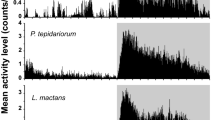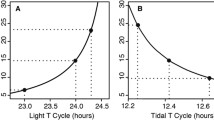Summary
-
1.
Individual adultHelix aspersa show a circadian rhythm of locomotor activity when kept in constant darkness, temperature, and high humidity.
-
2.
When kept for 14 months at temperatures with little annual variation from a mean of 17.4 °C, but with photoperiod varying in step with the seasons, snails moved and fed least during the short days from October to April. This is the time of hibernation in the field. Mating and egglaying ceased in September. All activities were resumed when days lengthened in January, before hibernation ends in the field.
-
3.
When transferred from the field to a photoperiod regime reversed by six months, snails re-phased their normal annual cycle of locomotor and reproductive activity to become most active in the long days.
-
4.
In an unvarying photoperiod of 12 h, snails exhibited a circannual cycle of movement, feeding, and reproductive activities which was faster than the normal annual cycle.
Similar content being viewed by others
References
Bailey SER (1975) The seasonal and daily patterns of locomotor activity in the snailHelix aspersa Müller, and their relation to environmental variables. Proc Malacol Soc (Lond) 41:415–428
Beeston D, Morgan E (1977) The locomotor activity rhythm of a tropical freshwater prosobranch. J Mollusc Stud 43:453–454
Blinn WC (1963) Ecology of the land snailsMesodon thyroidus andAllogona profunda. Ecology 44:498–505
Bliss CI (1970) Statistics in biology, vol 2. New York, McGraw-Hill
Dan NA (1978) Studies on the growth and ecology ofHelix aspersa Müller. Ph D Thesis, University of Manchester
Imhof G (1974) Der Einfluß von Temperatur und Photoperiode auf den Lebenszyklus einiger Süßwasserpulmonaten. Malacologia 14:393–395
Jeppesen LL (1977) Photoperiodic control of hibernation inHelix pomatia L. (Gastropoda: Pulmonata). Behav Proc 2:373–382
Jeppesen LL, Nygard K (1976) The influence of photoperiod, temperature and internal factors on the hibernation ofHelix pomatia L. (Gastropoda, Pulmonata). Vidensk Medd Dan Naturhist Foren 139:7–20
Pollard E (1975) Aspects of the ecology ofHelix pomatia. J Anim Ecol 44:305–329
Saunders DE (1977) An introduction to biological rhythms. Blackie, Glasgow London
Segal E (1960) In: Discussion following paper by A.J. Marshall. Cold Spring Harbor Symp Quant Biol 25:504–505
Stephens GJ, Stephens GC (1966) Photoperiodic stimulation of egglaying in the landsnailHelix aspersa. Nature 212:1582
Williams BG, Naylor E (1967) Spontaneously induced rhythm of tidal periodicity in laboratory rearedCarcinus. J Exp Biol 47:229–234
Author information
Authors and Affiliations
Additional information
I am grateful to Dr. N.A. Dan for the collection of some of the field data, to Mr Owen Jones and Mr Keith Jones of Colwyn Bay Civic Centre for making weather records available to me, and to Dr L.M. Cook and Miss A. Glaholm for their helpful comments on the manuscript.
Rights and permissions
About this article
Cite this article
Bailey, S.E.R. Circannual and circadian rhythms in the snailHelix aspersa Müller and the photoperiodic control of annual activity and reproduction. J. Comp. Physiol. 142, 89–94 (1981). https://doi.org/10.1007/BF00605480
Accepted:
Issue Date:
DOI: https://doi.org/10.1007/BF00605480




